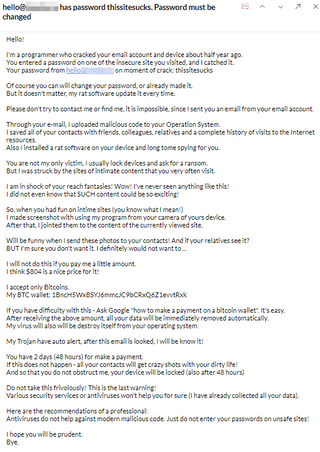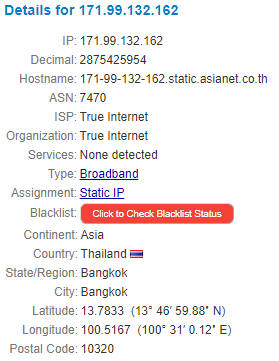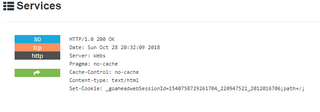801 Labs Research Portal
Phishing/Scam campaign research (ep. 2)

I got another email. This one was interesting, the email was the standard "we had a rat on your computer that we used to take dirty pictures of you, give us money or we will send it to all your contacts".
This is the email that I received.

It's a fairly standard "give us money or we send dirty photos we took to your contacts" kind of scam email, but this one actually does something that I have not seen previously. The scammers establish "credibility" by actually telling you what your password is. The scammers purchased a dumped site database (that assumedly did not hash or salt passwords), correlated the email address in the DB, and sent out an email.
This scam is incredibly effective when you consider that a vast majority of people use the same password for every account.
This scam also does something unique; they spoofed the sender of this email to be me.
Delivered-To: hello@[redacted]
Received-SPF: none (zoho.com: 171.99.132.162 is neither permitted nor denied by domain of [redacted]) client-ip=171.99.132.162; envelope-from=hello@[redacted]; helo=171-99-132-162.static.asianet.co.th;
Authentication-Results: mx.zohomail.com;
spf=none (zoho.com: 171.99.132.162 is neither permitted nor denied by domain of [redacted]) smtp.mailfrom=hello@[redacted]
Received: from 171-99-132-162.static.asianet.co.th (171-99-132-162.static.asianet.co.th [171.99.132.162]) by mx.zohomail.com
with SMTP id [redacted]; Mon, 29 Oct 2018 19:47:47 -0700 (PDT)
This was an interesting way of finding out that my mail server has incorrectly configured SPF records. This establishes ~darknet spooky hacker credibility~ by sending an email as you.
I am going to take a shot in the dark that they try several different techniques to do this. The first, is just standard SPF record spoofing to send the message. Since the boilerplate message contains Please don't try to contact me or find me, it is impossible, since I sent you an email from your email account., I am going to assume that sending mail as the recipient is part of the scam in general.
I also have another theory, that when they send the mail, if SPF records prevent spoofing, that they then try to authenticate with the target mail server to craft the email using the harvested credentials. This would also prove to the scammers if the harvested credentials were valid. This is a technique that has been seen in the wild in previous phishing campaigns, talked about here.
Digging a little deeper and looking at the email headers above, the IP that sent the email is 171.99.132.162. This IP appears to be a standard telecom IP address, belonging to a Broadband ISP located out of Bangkok, Thailand.

Riskiq also only has two carrier-assigned DNS records for this IP address

It appears that this IP is for sure a private (possibly residential IP). Is this IP the actual IP of the scammer? I hope they they wouldn't be so dumb, but who knows. Lets poke at it on Shodan.

The only running service on this host is a web server. Ohhh boy, that's great. Since there was no DNS record for a TLD pointing towards this IP, it's safe to assume that it is a residential/business host that opened up a web server for something, or the scammer is running this from their home IP and has a web server running. Lets see whats on it.

It appears this IP address is hosting a Hikvision camera control panel. Cameras are the number one compromised host for botnets or malicious activity on the internet. It's easy to assume that the person hosting this publicly accessible camera control panel left it with default passwords, and somebody logged in and compromised one of the cameras, adding it to a botnet.
Aside from trying to log in (illegal) there's nothing more I can do for this research. :(